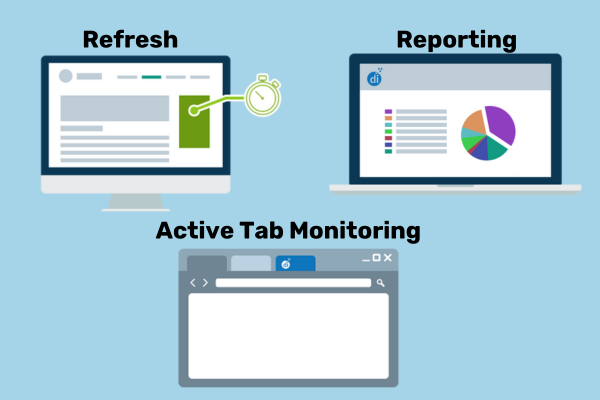
As a publisher, there are a few core metrics that are probably looked at on a daily basis. Daily visitors, Revenue, CPM, maybe fill rate if you’re more advanced. However, there’s one vital metric that you may be ignoring that can significantly impact revenue: viewability.
Welcome to “The Ultimate Guide to Ad Viewability”!
In today’s digital advertising landscape, ad viewability has become a crucial metric for publishers seeking to optimize their revenue and provide value to advertisers. While you’re likely looking at core metrics like revenue, CPM, or fill rate regularly, we’ve found a direct correlation between viewability and revenue. It’s an oft-overlooked metric that drives up inventory value and creates a healthier monetization system.
This comprehensive guide will walk you through the concept of viewability, its importance, and strategies to improve ad viewability on your website.
1. What Is Viewability?
In this chapter, we delve into the core concept of viewability. We’ll define what viewability means in the context of digital advertising and explore industry standards and guidelines. Additionally, we’ll shed light on the key metrics and measurements used to evaluate viewability effectively.
2. Why Viewability Matters
Discover why ad viewability matters not only to publishers but also to advertisers and brands. We’ll examine how viewability impacts the effectiveness of ad campaigns, the significance it holds for ad pricing and revenue, and the overall value it adds to the advertising ecosystem.
3. Factors Affecting Ad Viewability
Understanding the factors that influence ad viewability is essential for publishers looking to optimize their ad placements. We’ll explore the significance of ad placement and positioning, the role of different ad formats and sizes, the impact of page load times and user experience, and the importance of mobile responsiveness and device compatibility.
4. The Role of Ad Refresh and Lazy Load
Ad refresh can be a powerful strategy for improving ad viewability, but it requires careful implementation. In this chapter, we’ll define ad refresh, discuss its purpose, and explore its benefits and challenges. You’ll also learn how lazy load impacts viewability and effective strategies to optimize for both without compromising user experience.

5. Best Practices to Improve Ad Viewability
Discover practical best practices that can help you enhance ad viewability on your website. We’ll cover optimal ad placement strategies, ad format selection and customization, techniques to optimize page load times, responsive design and mobile optimization tips, A/B testing and performance tracking, and the importance of collaboration with ad networks and partners.
6. Tools and Technologies for Ad Viewability
In this chapter, we’ll explore the various tools and technologies available to measure and improve ad viewability. You’ll learn about ad verification and measurement tools, the capabilities and features of modern ad servers, and viewability analytics and reporting platforms that can provide valuable insights into your ad performance.
7. Future Trends in Ad Viewability
As technology continues to evolve, so does the landscape of ad viewability. In this chapter, we’ll discuss emerging trends, innovations, and potential challenges that publishers may face in the future. We’ll also provide predictions for the future of ad viewability and how you can stay ahead of the curve.
By prioritizing ad viewability, you’ll enhance user experience, maximize ad revenue, and build stronger partnerships with advertisers.
What is viewability?
Viewability refers to the measurement of how visible and viewable an ad is to website visitors. It tracks whether an ad was actually seen by users, taking into account factors like ad placement, scrolling behavior, and page layout. Viewability is an essential metric for publishers and advertisers alike because it provides insights into the effectiveness and value of digital ad campaigns.
The MRC and IAB guidelines state that a display ad is considered viewable if at least 50% of its pixels are in the visible portion of the browser window, and the ad remains in view for a minimum continuous duration of one second.
The formula for calculating viewability is as follows:
Viewability = (Viewable Ad Impressions ÷ Ad Impressions) x 100.
If you are having a hard time getting viewability data for your monetization program, just use the formula above to calculate it yourself!
A good starting benchmark for viewability that we use at diDNA is 80%. If viewability is below this number, there’s likely some room for improvement.

Why Viewability Matters
In today’s competitive digital advertising landscape, viewability holds immense significance for publishers. High viewability not only increases the value of your inventory but also makes it more appealing to buyers, whether they participate in programmatic ad auctions or engage in direct buys. Advertisers prioritize ad placements that offer high viewability because it ensures their ads are seen by the intended audience, maximizing the potential for engagement and conversions.
Moreover, viewability serves as an indicator of your website’s overall functionality and user experience. When your ads have high viewability rates, it demonstrates that your website is functioning properly without timing out, displaying errors, or experiencing other technical issues. This promotes trust and confidence among advertisers, as they can rely on your website to provide a seamless environment for their campaigns.
Another crucial aspect is the direct correlation between viewability and revenue. When your ads are highly viewable, they have a greater chance of capturing users’ attention and driving engagement. This, in turn, leads to increased click-through rates, conversions, and ultimately, higher revenue. Advertisers are more likely to allocate larger budgets to publishers with proven high viewability rates, as they see a clear return on investment and value in reaching a receptive audience.
By prioritizing viewability, publishers can enhance the value of their inventory, maximize ad performance, and drive revenue growth. It’s a win-win situation where advertisers benefit from effective ad placements, and publishers can maximize their monetization potential. Viewability serves as a key metric for success in the digital advertising ecosystem, fostering mutually beneficial relationships between publishers and advertisers.
The factors that impact ad viewability
Several factors play a crucial role in determining ad viewability on a publisher’s website. One of the most significant factors is page load times. Slow-loading pages not only frustrate users but also increase the likelihood of users leaving before ads fully load and become viewable. Optimal ad viewability is closely linked to fast page load times, ensuring that ads have sufficient time to render and appear on the screen before users navigate away.
Ad placement and positioning also heavily influence ad viewability. A sticky ad unit, positioned in a fixed location on the screen as users scroll, tends to have nearly 100% viewability since it remains in the viewport regardless of user interaction. On the other hand, ads placed towards the bottom of a page often suffer from low viewability rates, as users may not scroll down far enough to see them. Implementing techniques such as lazy loading, where ads are rendered at measured scroll distance, can help improve viewability for ads placed further down the page.
The importance of mobile cannot be overstated when considering ad viewability. With the significant growth of mobile device usage, ensuring ads are optimized for mobile screens is essential. Mobile responsiveness is crucial, as ads need to adapt seamlessly to different screen sizes and orientations. Mobile-friendly ad formats and placements that cater to user behaviors on mobile devices can significantly enhance viewability. Additionally, factors like page load times and ad positioning on mobile devices need to be carefully considered to provide a seamless and viewable ad experience.
Considering these factors—page load times, ad sizes and positioning, and the importance of mobile—can greatly impact the viewability of ads on a publisher’s website. By optimizing these elements, publishers can improve ad viewability, maximize ad exposure, and create a positive user experience, ultimately benefiting both advertisers and their own revenue generation.
The importance of smart ad refresh and lazy load
Ad refresh and lazy load are two valuable techniques that publishers can employ to enhance ad viewability and increase ad inventory on their websites.
Smart ad refresh, when implemented carefully, can be a powerful tool to improve programmatic ad revenue. By refreshing ads after a certain period, publishers can increase the volume of ads being seen by users who spend extended periods on a webpage. However, it is crucial to implement dynamic refresh timers that consider what ads are in view for a user and prevent refreshing ads that are out of view or on another browser tab. Care should be taken to avoid excessive ad refresh, which may lead to user annoyance, negatively impact the user experience, and limit the chances for a user to interact with an ad and lower the CTR (click through rate) further. This generally results in lower CPM values for ads. Furthermore, it may be prudent to disable ad refresh entirely for certain campaigns, particularly direct campaigns that benefit from super high viewability and high click-through rates, and pay a premium for no competition throughout their campaign’s delivery. This approach ensures that specific ads remain static and visible throughout the user’s session, maximizing their effectiveness.
Lazy load, on the other hand, is a valuable technique that contributes to improved viewability. By implementing lazy load, ads are loaded dynamically as the user scrolls, ensuring that ads are only loaded when they are about to come into view. This approach prevents ads from loading unnecessarily until users reach the specific locations of a webpage, increasing the likelihood of ads being viewable when users are most likely to engage with them. Lazy load optimizes page load times, reduces bandwidth usage, and ultimately enhances the overall viewability of ads on a publisher’s website.
By leveraging the benefits of smart ad refresh and lazy load, publishers can effectively improve ad viewability. Ad refresh can maximize revenue potential, but careful implementation is necessary to maintain a balance between refresh rates and user experience. Meanwhile, lazy load ensures that ads are loaded at the optimal moment, increasing the chances of ads being viewable and engaging to users. By combining these techniques with other viewability optimization strategies, publishers can create a positive and engaging ad experience, benefiting both advertisers and their own revenue generation.
Ways to improve ad viewability
To enhance ad viewability on your website, it’s crucial to follow best practices that optimize various aspects of your ad implementation. Here are some practical best practices to consider:
Optimal Ad Placement Strategies: Carefully consider the placement of your ads to maximize viewability. Ads near the top of a page tend to have lower viewability due to users scrolling past them before they have had time to render. Experiment with different ad placements, such as sticky ad units or in-content placements, to improve ad viewability and user engagement.
Ad Format Selection and Customization: Choose ad formats that are inherently viewable and complement your website’s design. Adaptive ad units that bid appropriate ad sizes to various screen sizes and devices are essential for ensuring viewability across various platforms. Additionally, customize ad formats to blend seamlessly with your website’s aesthetics without compromising visibility.
Techniques to Optimize Page Load Times: Optimize your website’s performance to reduce page load times. Faster-loading pages ensure that ads have sufficient time to render and become viewable before users lose interest or navigate away. Compress images, minimize code, leverage caching, and implement content delivery networks (CDNs) to improve overall page load speed.
A/B Testing and Performance Tracking: Continuously test and optimize your ad placements, formats, and other variables using A/B testing methodologies. Experiment with different strategies to identify the approaches that yield the highest viewability rates. Track key performance metrics, such as viewability, click-through rates, time on page, and engagement, to gain insights into what resonates best with your audience.
Collaboration with Ad Networks and Partners: Foster collaborative relationships with ad networks and partners. Stay informed about industry best practices and emerging viewability standards. Engage in discussions to gain insights and access tools provided by your ad network partners to enhance viewability tracking, ad serving, and optimization.
Implementing these best practices can significantly improve ad viewability on your website. Remember that continuous monitoring, analysis, and adaptation are key to ongoing optimization. By prioritizing viewability, you create a positive user experience, attract advertisers, and maximize the revenue potential of your ad inventory.
Tools and Technologies to Improve Ad Viewability
In the realm of ad viewability, there are several tools and technologies available to help publishers measure and improve their ad performance. Let’s explore some of these tools and their functionalities:
Ad Verification and Measurement Tools: Ad verification tools play a crucial role in assessing ad viewability. They provide comprehensive reporting and analysis on viewability metrics, including viewable impressions, time-in-view, and ad fraud detection. Popular ad verification vendors include Moat, Integral Ad Science (IAS), DoubleVerify, and Oracle Data Cloud. These tools offer robust measurement capabilities to help publishers gain insights into their ad viewability performance.
Modern Ad Servers: Ad servers serve as a central hub for managing and delivering digital ads. They often include features and capabilities to optimize ad viewability. Ad servers, such as Google Ad Manager, provide viewability tracking, ad rotation, and targeting options that enable publishers to enhance ad viewability. These servers also offer integration with third-party measurement and verification tools for comprehensive analysis.
Viewability Analytics, Optimization and Reporting Platforms: Dedicated viewability analytics, optimization, and reporting platforms focus on providing publishers with detailed insights into ad viewability performance. These platforms consolidate data from various sources, including ad servers and verification tools, and present comprehensive reports and visualizations, as well as use technology to increase ad viewability.
Real-Time Bidding (RTB) Platforms: RTB platforms, commonly used in programmatic advertising, provide opportunities for publishers to sell their inventory to advertisers in real-time auctions. These platforms often incorporate viewability metrics as part of their bidding algorithms, allowing advertisers to bid higher for more viewable impressions. Leading RTB platforms offer viewability-focused features that help maximize the value of publishers’ ad inventory.
By leveraging these tools and technologies, publishers can gain valuable insights into their ad viewability performance and make informed decisions to optimize their strategies. From verification and measurement tools to modern ad servers and viewability analytics platforms, each tool plays a unique role in helping publishers monitor, analyze, and improve their ad viewability. Remember to explore the specific functionalities and integrations offered by these tools to find the ones that best suit your needs and objectives.
The future of ad viewability
The future of ad viewability promises exciting trends and innovations that will shape the digital advertising landscape. Here are some potential developments to consider:
Advanced Measurement Techniques: As the industry becomes more sophisticated, we can expect advancements in measurement techniques for ad viewability. Innovations may include the use of machine learning algorithms to enhance measurement accuracy and predictive models to estimate viewability before ads are served. These advancements will provide publishers with deeper insights into ad performance and enable proactive optimization strategies.
Cross-Platform Viewability: With users consuming content across multiple devices, ensuring viewability across platforms will become increasingly important. Future trends will focus on developing consistent viewability standards and measurement methodologies that account for different device types and user behaviors. Publishers will need to adopt responsive design and proven ad delivery platforms to provide seamless and viewable ad experiences on various screens.
Interactive and Immersive Ad Experiences: Emerging technologies like augmented reality (AR) and virtual reality (VR) have the potential to revolutionize ad viewability opportunities. Interactive and immersive ad experiences can captivate users’ attention, driving higher viewability and engagement rates. Publishers will need to research these technologies and explore innovative ways to integrate interactive elements and immersive ad formats into their websites.
Privacy and Consent Considerations: With increasing privacy regulations and consumer awareness, publishers must prioritize user consent and data protection. Future trends in ad viewability will include developing privacy-friendly measurement techniques that respect user preferences. Publishers will need to navigate the evolving landscape of privacy regulations and adopt strategies that prioritize transparency, consent management, and data privacy to maintain user trust and comply with regulations.
Artificial Intelligence (AI) for Viewability Optimization: Artificial intelligence will play a significant role in optimizing ad viewability. AI-powered algorithms can analyze vast amounts of data to identify patterns and trends, allowing publishers to make data-driven decisions for ad placements and optimizations. AI can automate the process of identifying optimal ad placements, adjusting refresh rates, and personalizing ad experiences based on user behavior. By leveraging AI, publishers can improve viewability by dynamically adapting ad placements and formats to maximize user engagement and viewability metrics. Integrating AI into viewability strategies will enable publishers to stay agile and responsive in a rapidly evolving advertising landscape.
To stay ahead of the curve in the future of ad viewability, publishers should continuously monitor industry trends, embrace technological advancements, and adapt their strategies accordingly. Remaining proactive in adopting emerging measurement techniques, optimizing for cross-platform experiences, exploring interactive ad formats, prioritizing privacy and consent, and leveraging contextual and native advertising will help publishers enhance ad viewability, deliver compelling user experiences, maximize revenue, and build strong relationships with advertisers.

